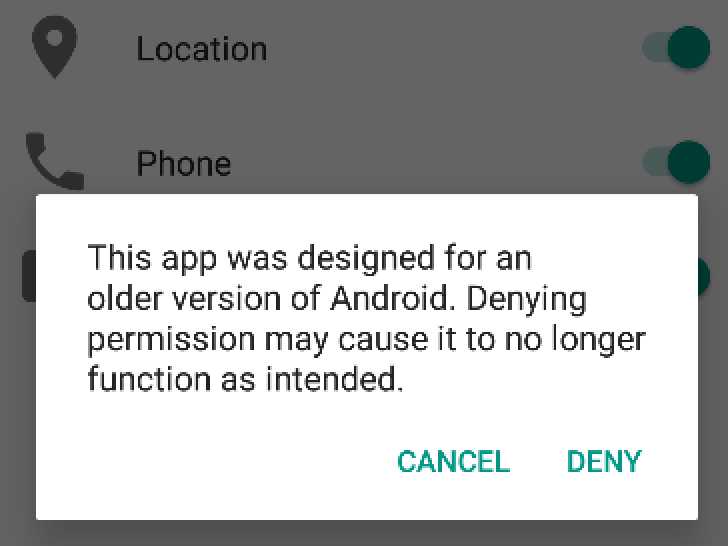标签:
Table 1. Dangerous permissions and permission groups.
| Permission Group | Permissions |
|---|---|
CALENDAR |
|
CAMERA |
|
CONTACTS |
|
LOCATION |
|
MICROPHONE |
|
PHONE |
|
SENSORS |
|
SMS |
|
STORAGE |
targetSdkVersion is 23 or higher, the app requests permissions from the user at run-time. The user can revoke the permissions at any time, so the app needs to check whether it has the permissions every time it runs. For more information about requesting permissions in your app, see the Working with System Permissions training guide.targetSdkVersion is 22 or lower, the system asks the user to grant the permissions when the user installs the app. If you add a new permission to an updated version of the app, the system asks the user to grant that permission when the user updates the app. Once the user installs the app, the only way they can revoke the permission is by uninstalling the app.
PERMISSION_GRANTED if you have the permission, or PERMISSION_DENIED if not.if (PackageManager.PERMISSION_GRANTED == ContextCompat.checkSelfPermission(MainActivity.this, Manifest.permission.READ_CONTACTS)) {
//has permission, do operation directly
ContactsUtils.readPhoneContacts(this);
Log.i(DEBUG_TAG, "user has the permission already!");
} else {
//do not have permission
if (PackageManager.PERMISSION_GRANTED == ContextCompat.checkSelfPermission(MainActivity.this, Manifest.permission.READ_CONTACTS)) {
//has permission, do operation directly
ContactsUtils.readPhoneContacts(this);
Log.i(DEBUG_TAG, "user has the permission already!");
} else {
//do not have permission
Log.i(DEBUG_TAG, "user do not have this permission!");
// Should we show an explanation?
if (ActivityCompat.shouldShowRequestPermissionRationale(MainActivity.this,
Manifest.permission.READ_CONTACTS)) {
// Show an explanation to the user *asynchronously* -- don‘t block
// this thread waiting for the user‘s response! After the user
// sees the explanation, try again to request the permission.
Log.i(DEBUG_TAG, "we should explain why we need this permission!");
} else {
// No explanation needed, we can request the permission.
Log.i(DEBUG_TAG, "==request the permission==");
ActivityCompat.requestPermissions(MainActivity.this,
new String[]{Manifest.permission.READ_CONTACTS},
MY_PERMISSIONS_REQUEST_READ_CONTACTS);
// MY_PERMISSIONS_REQUEST_READ_CONTACTS is an
// app-defined int constant. The callback method gets the
// result of the request.
}
}
onRequestPermissionsResult() 方法,传回用户的响应.@Override
public void onRequestPermissionsResult(int requestCode,
String permissions[], int[] grantResults) {
switch (requestCode) {
case MY_PERMISSIONS_REQUEST_READ_CONTACTS: {
// If request is cancelled, the result arrays are empty.
if (grantResults.length > 0
&& grantResults[0] == PackageManager.PERMISSION_GRANTED) {
// permission was granted, yay! Do the
// contacts-related task you need to do.
ContactsUtils.readPhoneContacts(this);
Log.i(DEBUG_TAG, "user granted the permission!");
} else {
// permission denied, boo! Disable the
// functionality that depends on this permission.
Log.i(DEBUG_TAG, "user denied the permission!");
}
return;
}
// other ‘case‘ lines to check for other
// permissions this app might request
}
}
onRequestPermissionsResult() 回调方法, 并传回PERMISSION_GRANTED的结果.$ adb shell pm list permissions -d -g
标签:
原文地址:http://www.cnblogs.com/summers/p/5383458.html